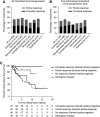Response to First Course of Intensified Immunosuppression in Genetically Stratified Steroid Resistant Nephrotic Syndrome
- PMID: 32317330
- PMCID: PMC7341765
- DOI: 10.2215/CJN.13371019
Response to First Course of Intensified Immunosuppression in Genetically Stratified Steroid Resistant Nephrotic Syndrome
Abstract
Background and objectives: Intensified immunosuppression in steroid-resistant nephrotic syndrome is broadly applied, with disparate outcomes. This review of patients from the United Kingdom National Study of Nephrotic Syndrome cohort aimed to improve disease stratification by determining, in comprehensively genetically screened patients with steroid-resistant nephrotic syndrome, if there is an association between response to initial intensified immunosuppression and disease progression and/or post-transplant recurrence.
Design, setting, participants, & measurements: Pediatric patients with steroid-resistant nephrotic syndrome were recruited via the UK National Registry of Rare Kidney Diseases. All patients were whole-genome sequenced, whole-exome sequenced, or steroid-resistant nephrotic syndrome gene-panel sequenced. Complete response or partial response within 6 months of starting intensified immunosuppression was ascertained using laboratory data. Response to intensified immunosuppression and outcomes were analyzed according to genetic testing results, pattern of steroid resistance, and first biopsy findings.
Results: Of 271 patients, 178 (92 males, median onset age 4.7 years) received intensified immunosuppression with response available. A total of 4% of patients with monogenic disease showed complete response, compared with 25% of genetic-testing-negative patients (P=0.02). None of the former recurred post-transplantation. In genetic-testing-negative patients, 97% with complete response to first intensified immunosuppression did not progress, whereas 44% of nonresponders developed kidney failure with 73% recurrence post-transplant. Secondary steroid resistance had a higher complete response rate than primary/presumed resistance (43% versus 23%; P=0.001). The highest complete response rate in secondary steroid resistance was to rituximab (64%). Biopsy results showed no correlation with intensified immunosuppression response or outcome.
Conclusions: Patients with monogenic steroid-resistant nephrotic syndrome had a poor therapeutic response and no post-transplant recurrence. In genetic-testing-negative patients, there was an association between response to first intensified immunosuppression and long-term outcome. Patients with complete response rarely progressed to kidney failure, whereas nonresponders had poor kidney survival and a high post-transplant recurrence rate. Patients with secondary steroid resistance were more likely to respond, particularly to rituximab.
Keywords: Base Sequence; Biopsy; Cohort Studies; Disease Progression; Exome; Genetic Testing; Radar; Registries; Renal Insufficiency; Rituximab; immunosuppression; nephrotic syndrome; pediatric nephrology; progression of renal failure; transplant outcomes.
Copyright © 2020 by the American Society of Nephrology.
Figures





Comment in
-
Individualizing Treatment of Steroid-Resistant Nephrotic Syndrome: Registries to the Fore.Clin J Am Soc Nephrol. 2020 Jul 1;15(7):920-922. doi: 10.2215/CJN.08080520. Clin J Am Soc Nephrol. 2020. PMID: 32601094 Free PMC article. No abstract available.
References
-
- Trautmann A, Bodria M, Ozaltin F, Gheisari A, Melk A, Azocar M, Anarat A, Caliskan S, Emma F, Gellermann J, Oh J, Baskin E, Ksiazek J, Remuzzi G, Erdogan O, Akman S, Dusek J, Davitaia T, Özkaya O, Papachristou F, Firszt-Adamczyk A, Urasinski T, Testa S, Krmar RT, Hyla-Klekot L, Pasini A, Özcakar ZB, Sallay P, Cakar N, Galanti M, Terzic J, Aoun B, Caldas Afonso A, Szymanik-Grzelak H, Lipska BS, Schnaidt S, Schaefer F; PodoNet Consortium: Spectrum of steroid-resistant and congenital nephrotic syndrome in children: The PodoNet registry cohort. Clin J Am Soc Nephrol 10: 592–600, 2015 - PMC - PubMed
-
- Trautmann A, Schnaidt S, Lipska-Ziętkiewicz BS, Bodria M, Ozaltin F, Emma F, Anarat A, Melk A, Azocar M, Oh J, Saeed B, Gheisari A, Caliskan S, Gellermann J, Higuita LMS, Jankauskiene A, Drozdz D, Mir S, Balat A, Szczepanska M, Paripovic D, Zurowska A, Bogdanovic R, Yilmaz A, Ranchin B, Baskin E, Erdogan O, Remuzzi G, Firszt-Adamczyk A, Kuzma-Mroczkowska E, Litwin M, Murer L, Tkaczyk M, Jardim H, Wasilewska A, Printza N, Fidan K, Simkova E, Borzecka H, Staude H, Hees K, Schaefer F; PodoNet Consortium: Long-term outcome of steroid-resistant nephrotic syndrome in children. J Am Soc Nephrol 28: 3055–3065, 2017 - PMC - PubMed
-
- Mekahli D, Liutkus A, Ranchin B, Yu A, Bessenay L, Girardin E, Van Damme-Lombaerts R, Palcoux JB, Cachat F, Lavocat MP, Bourdat-Michel G, Nobili F, Cochat P: Long-term outcome of idiopathic steroid-resistant nephrotic syndrome: A multicenter study. Pediatr Nephrol 24: 1525–1532, 2009 - PubMed
-
- Vinai M, Waber P, Seikaly MG: Recurrence of focal segmental glomerulosclerosis in renal allograft: An in-depth review. Pediatr Transplant 14: 314–325, 2010 - PubMed
Publication types
MeSH terms
Substances
Grants and funding
LinkOut - more resources
Full Text Sources
Other Literature Sources

